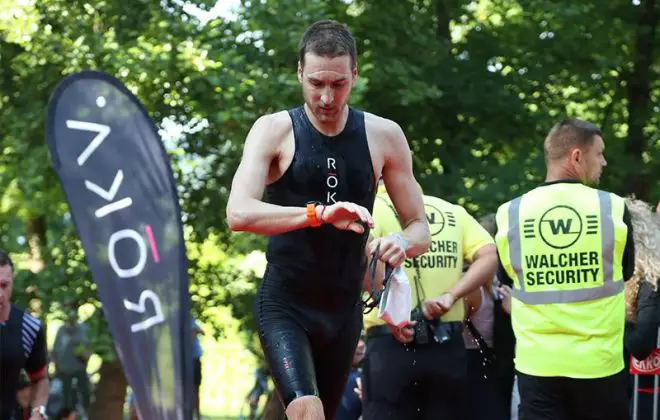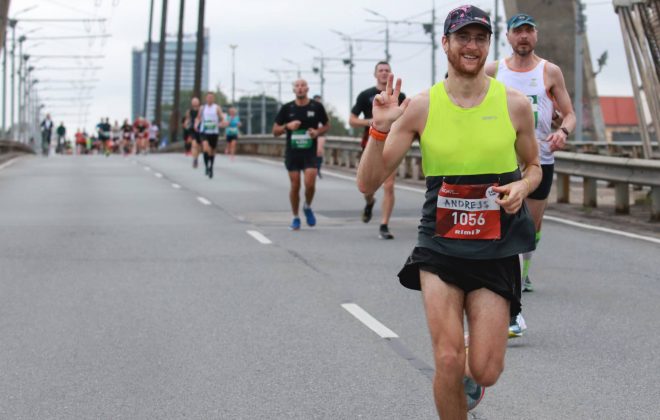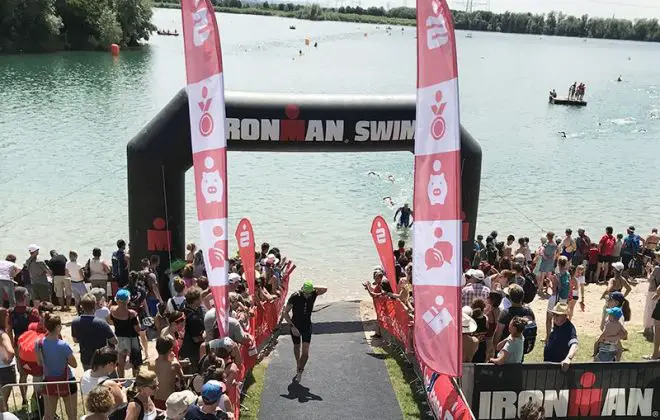7 Practical Tips For Running A Strong Marathon In Warm Weather
Running a marathon – in warm weather or not – became sort of a season highlight for me. I even came to enjoy the feelings & emotions you experience at 30K when you’re hurting, but totally in the moment. Facing your doubts. Getting to know how far you can go. And doing that with thousands of fellow runners and spectators beside you.
Not to mention the finish line that culminates this self-promoted suffering and months of daily commitments.
What I like to do after every race is sit down and analyze it. Review what went well, what didn’t and what I can do about it. I thrive on this self-analysis and digging out ways how I can do better. And it serves as a great case study for this blog also.
Unlike my other race reports, this post will be about my experience of running a marathon in warm weather. And, in particular, how to get the most of it.
But before jumping into the story, some physiology first. For context.
Exercising in warm weather
There’s a reason why most long distance races take place during either autumn or spring – weather. Besides the distance itself, running a marathon in warm weather adds an additional variable which can turn everything upside down.
As we exercise, energy generated in our muscles produces heat. Great news for cold weather races, as all that heat helps to keep us warm. However, when temperature rises above a certain threshold (typically above 15°C for marathon running), it no longer benefits performance.
Cooling off is body’s natural defense mechanism from overheating and in warm weather it spends a lot of energy on that. So, during the exercise the more we sweat the less energy remains for our muscles to use.
Between performance and self-preservation the body will always choose to stay alive.
The main challenge of running a marathon is the sheer length of the distance. This race depletes body’s reserves gradually, which often forces athletes to make tactical mistakes in the first half of it. In warm weather this process is even quicker, so athletes who ignore early warning signs are setting themselves up for a very tough finish.
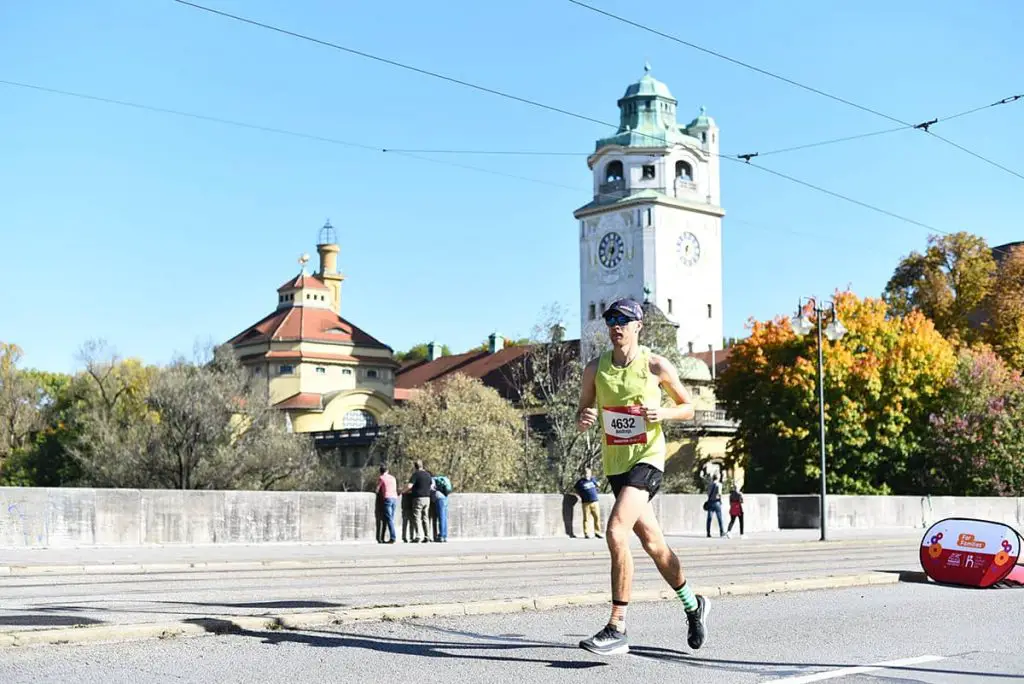
However, with some preparation it is possible to perform well in the heat. Take Olympics or Ironman triathlons as an example. These events take place in summer and often in very hot and humid conditions. Yet, athletes still perform at the top of their ability and even set Olympic and World records.
Practical tips for running a marathon in warm weather
So, back to the story and my 7 tips for running a marathon in warm weather.
Ever since I ran my first marathon I envisioned myself returning to Munich and smashing my previous result on the same course.
The timing was great. This time I was coming off a solid 6-month-long training block for Ironman Austria and was very confident in my fitness. So, 3 months after the Ironman I was back at Munich marathon – excited and ready.
However, it was nothing like the last time. The weather was surprisingly warm and instead of expected +10°C the forecast predicted +22°C and sunny for race day.
Tip #1 – Expose the body to different stress factors in training
In preparation for Ironman I tried to put my body through as many small stresses as possible to help it adapt. The idea was to prepare myself physically and mentally for the long day and potential change in conditions during it. Kind of, to make myself as ‘bulletproof’ as possible.
I expected that race to be very hot and did lots of easy running throughout the summer in temperatures over 30°C. On top of that, I adapted a practice of taking a cold shower almost every morning, which, supposedly stimulates mitochondrial growth and helps the body learn to regulate its temperature better in both cold and heat.
Read also: Minimalist Ironman Training Program & Tips For Busy Triathletes
I believe all of this heat preparation I did over the summer helped me during this marathon in warm weather as well. Most importantly, it helped me better understand how my body responds to the heat and how it feels after exercising for hours in the heat.
Overall, after Ironman training I became more comfortable running in the heat. Now when I remember my ‘subtropic running fiasco’ in Jakarta I smile at how naive and inexperienced I was there.

The Resilient Athlete
A Self-Coaching Guide to Next Level Performance in Sports & Life
Are you aiming to become a resilient athlete who is able to withstand any pressure? Be able to jump on any opportunity? Take any challenge life throws at you head on?
Then this book is for you.
Learn moreTip #2 – Minimal clothing
So yeah, Munich should have been a cold marathon. The last time I ran it the weather was +6°C at the start and +12°C at the finish. I was almost pulled over by Fashion Polizei for dressing like a scuba diver that year – in tights and long sleeve shirt. And even though I felt really comfortable for the first 10K, it got increasingly hot after that.
After that experience I always think what will be the weather at the finish. Despite how cold it might be at the start. I’d rather put on some old clothes and throw them out than overdress and suffer during the race.
Not this year, though.
The race start was at 10am and by that time it was already +15°C. In short shorts and singlet I felt quite warm already during the warmup.
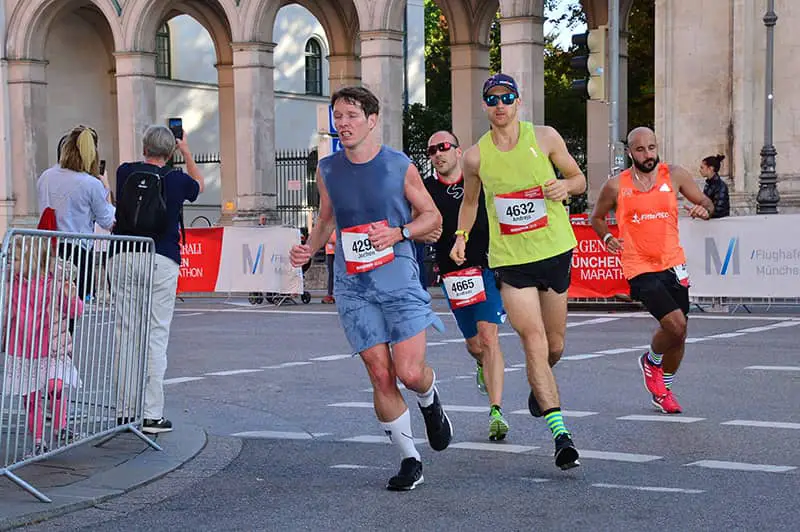
Tip #3 – Recover fully
Training in the weeks leading up to the race suggested I was somewhere in a 3hr marathon shape. Maybe 1-2 minutes faster if all goes well.
However, immediately after the start I knew something’s off. Despite a good warmup my legs felt a little heavier than I expected. I kept thinking – is it because of the weather or am I just tired?
As usual, I ran the first 2K easy. Typically I try to ignore the watch at this point of the race, but I couldn’t help but notice that my heart rate was high right away. It jumped to 155-158 in the first couple of minutes, which is top of Z3 for me. That wouldn’t be a problem if the splits were fast, but at 4:30 min/km they weren’t.
These signals were a good reminder for me to be careful. And an indicator that breaking 3 hours is not going to happen today. Even though I feel ok now, everything might change in an hour or two.
When the body is under stress or under-recovered its ability to regulate temperature worsens. This, in turn, can have a significant impact on the athlete who plans to run a marathon in warm weather. To increase the chance of a good race it’s important to back off training and reduce stress in days leading up to a race. The body needs maximum rest at this point of time.
Read also: Marathon Taper Tips And My 2 Week Marathon Taper Schedule
This is where I’ve missed the mark, as my rest could have been better. I should have done more mobility work in the days leading up to the race, which would freshen up the muscles.
On top of that, the day before the race turned out a little hectic for me. I did a very light 20-minute jog in the morning and then spent most of the day on my feet, which did not help with recovery. My resting heart rate on race day was some 5 beats higher than my average, even though I slept perfectly fine.
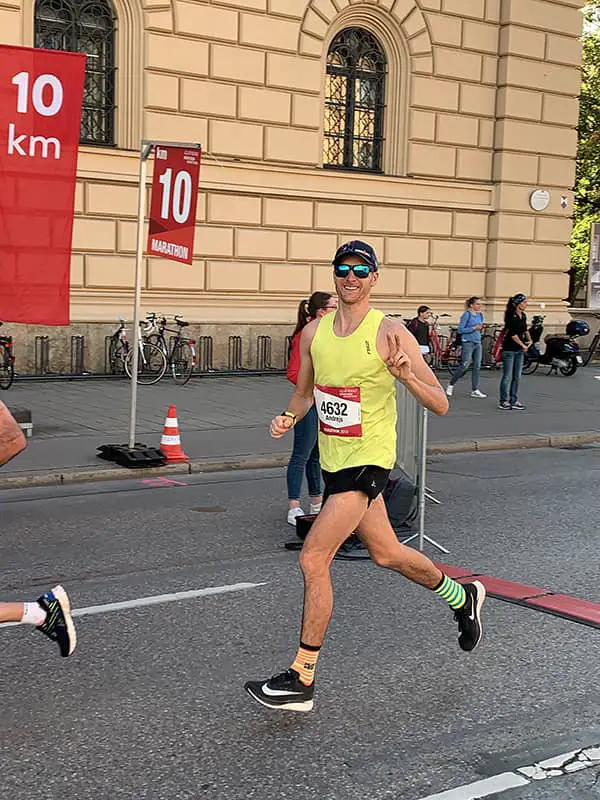
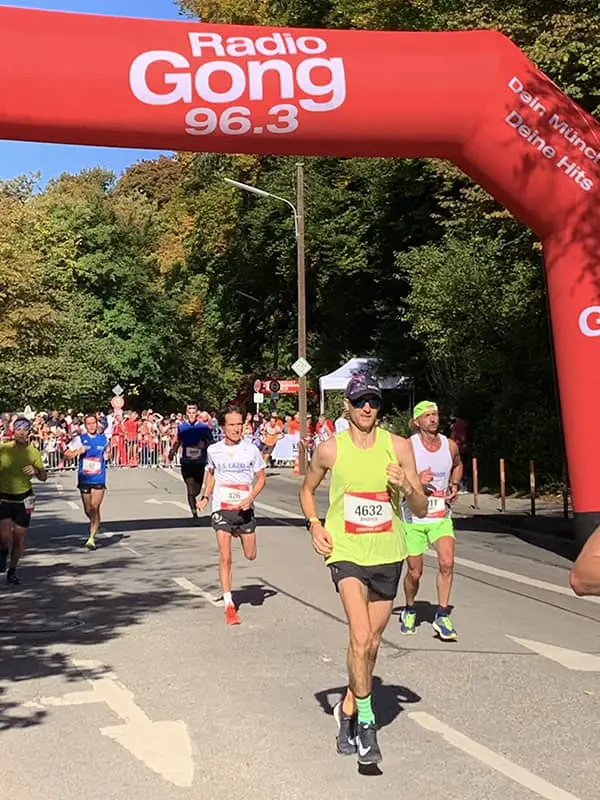
Tip #4 – Adjust your expectations
After the first couple of kilometers we left the Olympic park behind and continued running through the city. By now I’ve settled into my pace and kilometers started ticking – 4:16, 4:18, 4:20, 4:14… The pace improved, but I also expected to run a little faster through this section – hills came later. My heart rate was exactly where I wanted it to be – at around 160-162 (my low Z4).
Yet, I was bummed by the fact that I was under-recovered and that conditions weren’t optimal. I’ve put a lot of effort into preparation, but the race probably will not go as planned.
But then again, I couldn’t give up. I had a long way ahead and the best thing I could do was to accept the situation and make the most of it.
Read also: First Time Marathoners – 18 Training, Taper & Race Day Tips
So, I told myself it’s not always about the result or a PB. Things are different this time. After all, finishing a marathon is a great achievement whichever way you put it. So, I have to let go of expectations and take it one kilometer at a time.
In such warm conditions and so early in the race it was more important than ever to listen to the body and not go out too hard.
Tip #5 – Focus on effort, not pace
5K went by very quickly in these thoughts. Letting go of expectations made me feel better and helped to return to the present moment.
I found myself surrounded by 4-5 runners running the same speed as I was. In such small group we carried on through the center of Munich and then into the city’s park. The pace was still around 4:15 min/km and I though maybe that beginning was just a rough patch. Ok, a sub-3 finish was not possible, but maybe I could still get a PB.
Just as I got excited some of the runners from our small group started to slowly pull away. I followed, but soon backed off because my heart rate jumped as I tried to close the gap.
I’ve been here before – my first half felt good, but in the end wheels started to fall off.
Which is why when running a marathon it’s important to think about the effort, not the pace. Athletes may or may not maintain the pace throughout the whole race. That depends on how well recovered and how prepared they are to run that pace. Effort is a different thing. It takes into account body’s condition on a specific day and helps to maximize that.
An easy way how to measure effort is to use heart rate training zones.
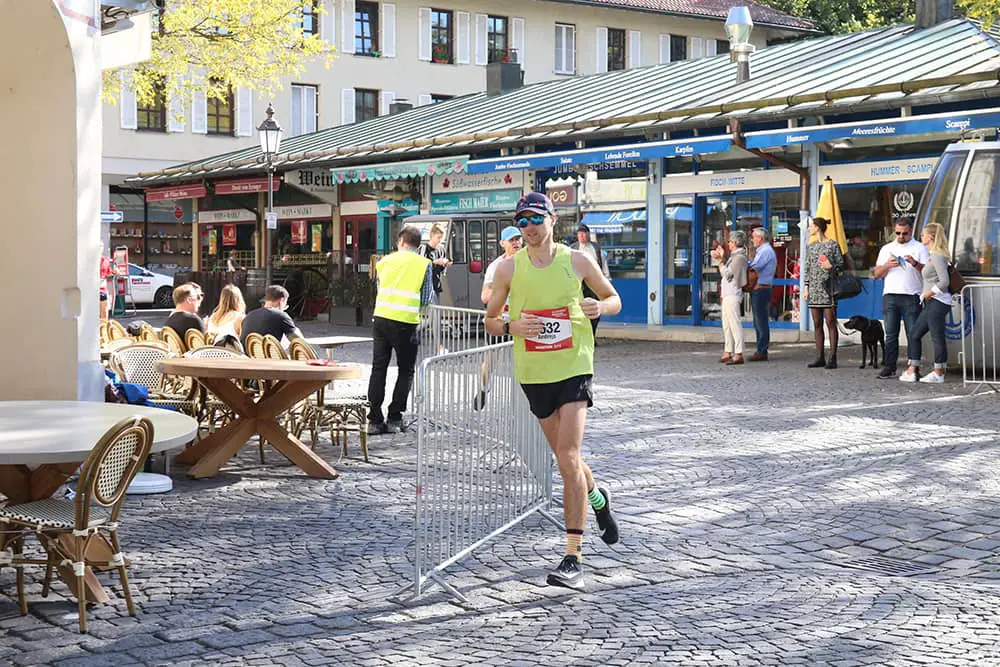
Tip #6 – Time your nutrition
The exit from the park marked the halfway mark which I went through in 1:32:30. Not too bad, but the challenging part was still ahead. And it started with an almost 2K long uphill which got my lungs puffing.
By the time I reached the top of the hill it was almost midday. The sun was high and I finally started to feel that impact from the warm weather. Fatigue that typically accumulates throughout the second half showed up earlier. And while there was an aid station every 2-3 kilometers the thirst for water, iso-drink and anything sweet was getting more intense.
My nutrition plan was the same as the one I used during my 3:07 marathon in Berlin last year. Besides the common sense of drink before thirsty and drink at every aid station I also took a gel every 30-40min.
Gels with extra sodium and electrolytes will work best for a marathon in warm weather, because with sweat we lose not only water but also precious minerals. Replenishing sodium, in particular, will help to absorb the water better and deliver it to working muscles.
Read also: Top 10 Endurance Athlete Diet Mistakes And How To Avoid Them
Even though I still caught a rough patch at 25K (who doesn’t?), having a gel as something to look forward to was a good distraction. And I found that in warm weather 30 to 40 minutes is also a good time window for the gel to work. Whenever I was feeling low on power I didn’t have to wait long for a small shot of energy.
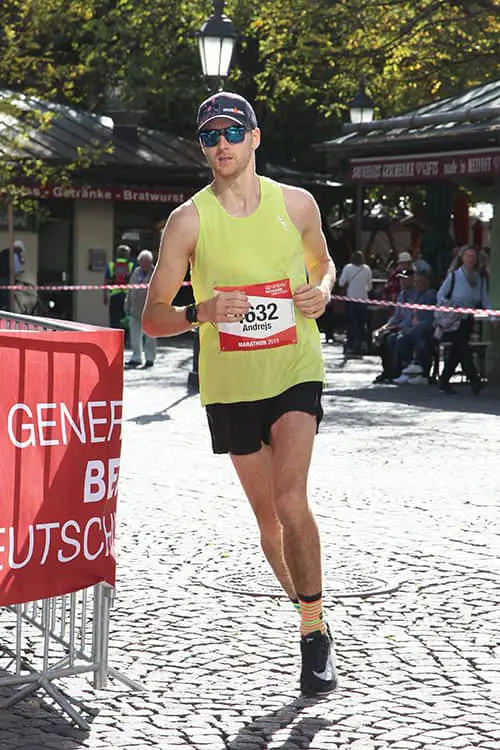
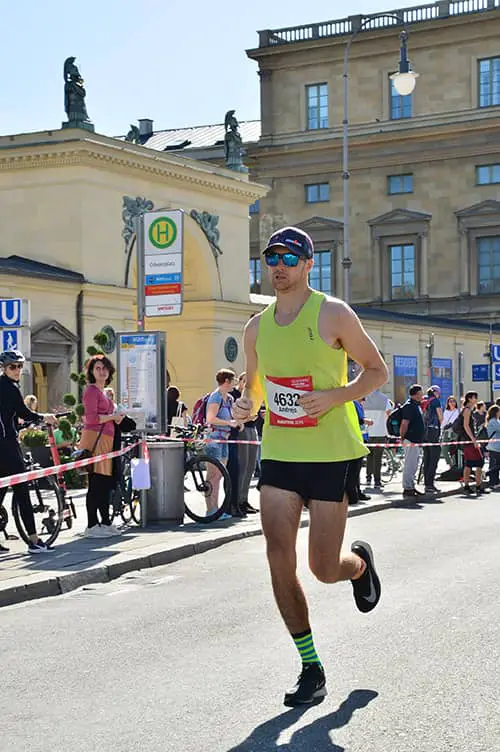
Tip #7 – Keep yourself cool
As tasty as it feels for an empty stomach, sugar boost cannot last forever. Nor does it give that much boost anyway.
Running the 30-35K section felt like running through a desert. Even though +22°C doesn’t sound as much, it does its damage. My pace dropped to 4:40 min/km on a hilly section and didn’t recover as I generally started to feel tired. And a little dizzy.
I wanted to stop really badly and even walked 2 aid stations to get as much liquid and iso-drink in me as possible. I also poured water on my head at every station starting from 21K, which did make me feel better.
Pouring water on the head is, actually, a great way to help the body cool itself down. Any small attempt adds up – pouring water, trying to run in the shade, keeping sponges close to skin, if available. That essentially substitutes the process of sweating, so the body needs to expend less energy.
The best place to pour is the back of the head and back of the neck. Watch out for getting your feet wet, though. Otherwise you risk developing blisters.
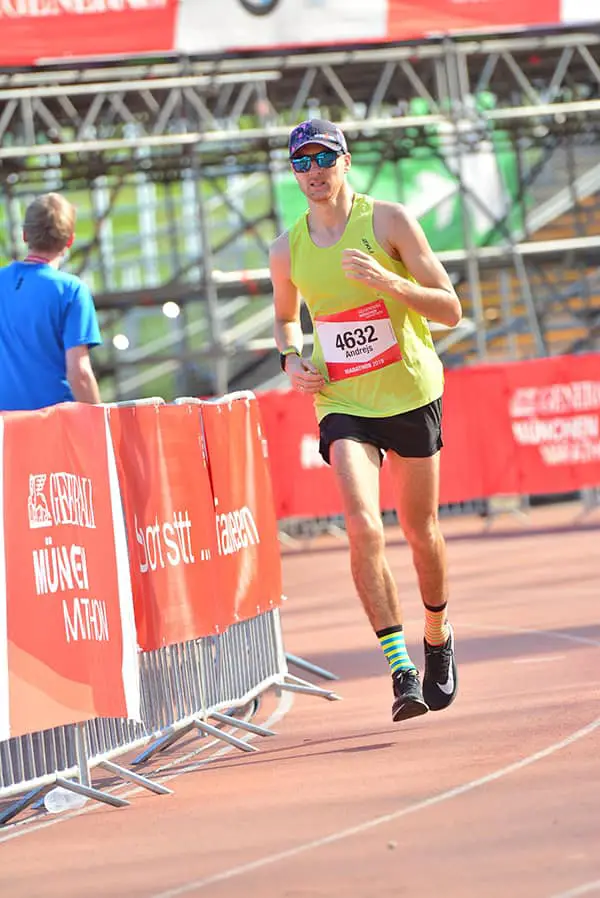
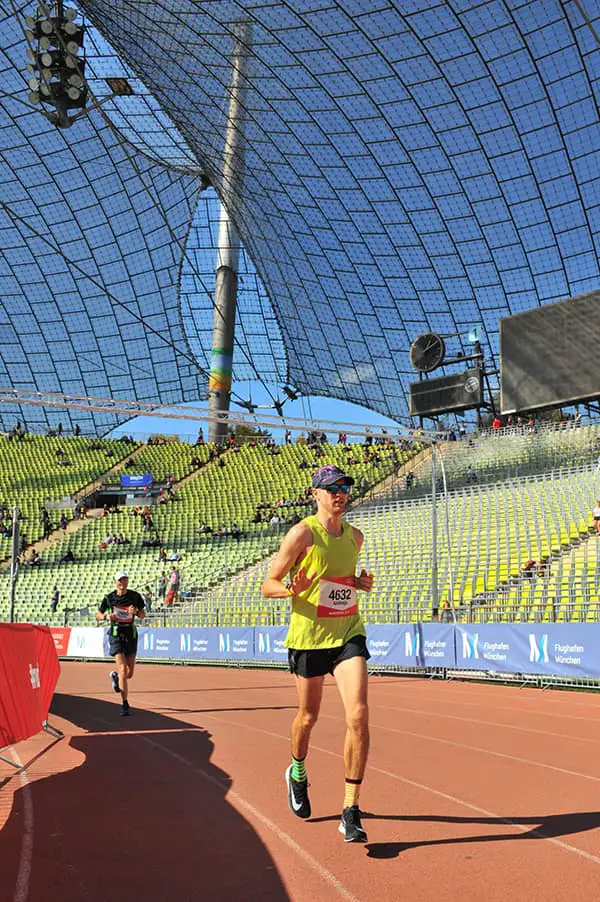
Finish strong
Delirious I got to 36K. Gave Kristine a kiss and swallowed my last gel.
Both of these actions gave me extra energy. I won’t explore whether those were endorphins from the kiss or 100mg of caffeine in the gel. All I can say is it was like a turbo boost. Even though my legs were in pain, I didn’t really think about it. I had tunnel vision and just one thought in my head – 5K left.
As much as it hurts, those last kilometers of the marathon is a surreal experience. You’ve been running for 3 hours, yet you still give everything you have left. You barely feel the legs and on the final push you just pray not to trip over, because there’s no way you’d be able to stand back up. And you don’t care anymore how fast you’re running – just the fact that you’re able to push yourself this late in the race is already an achievement.
After that final 5K push that felt epic I finished in 3:12:20. Not as fast as expected, but still better than my last Munich marathon.
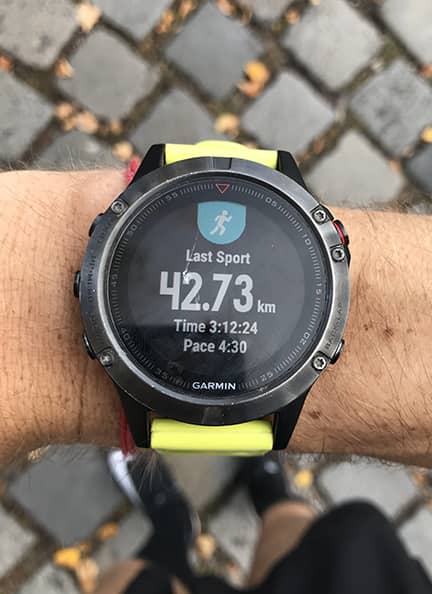
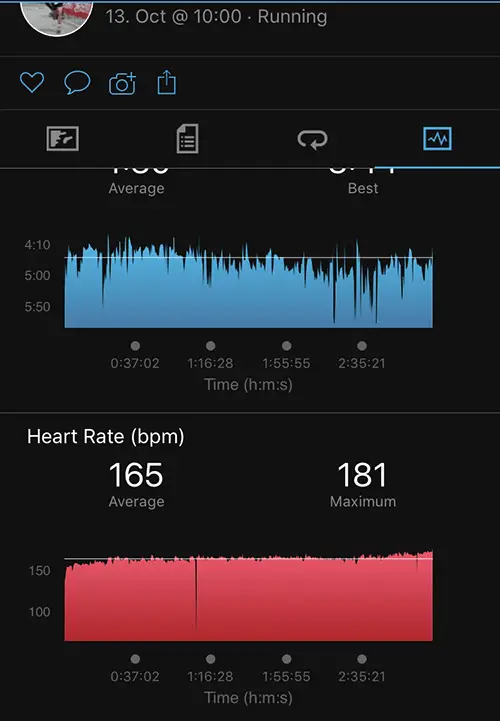
The big picture
The tips I shared above are actually relevant for anyone attempting to run a marathon – be it for the first time or the twenty first. Things I shared are simple, yet many athletes get them wrong. Warm weather only makes these mistakes more visible and damaging.
But even despite all the training, planning and nutrition strategy marathon is unpredictable. It’s a combination of many factors – physical condition, recovery, mental preparedness and so on. Weather is only one of those factors.


Ever since I ran my first marathon I though I’d come back and finish stronger on the same course. I kind of did that this time, but it was still tough. I think running a marathon is mostly a mental game, which is why it will always be difficult.
And in that space I feel I accomplished my goal – I think I ran the best race I could on that particular day and didn’t quit when it got hard. Instead, I pushed through and used every bit of energy I had left.
And that perseverance, being in the moment and leaving it all out there is what keeps me going and signing up for more.
Did you find this information useful? Share the post with others using the buttons below.
Tags In
Andrejs
Related Posts
Leave a Reply Cancel reply
GET A FREE TRAINING PLAN
Subscribe to my email list and get access to a free 4-week “back in shape” training plan
You’ll also get two full-body strength sessions and some other goodies!

How did I get here?
Hey there! My name is Andrejs and I am here to inspire, entertain and get you fit for any adventure.
I went from being an over trained pro athlete to an endurance coach sharing how to listen to your body and live life to the fullest.
Traveling, new sports & activities brought new meaning to my training and made it much more effective, fun and enjoyable. And I'm here to help you do the same.
